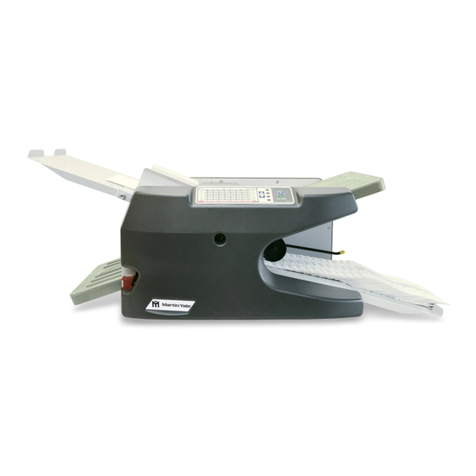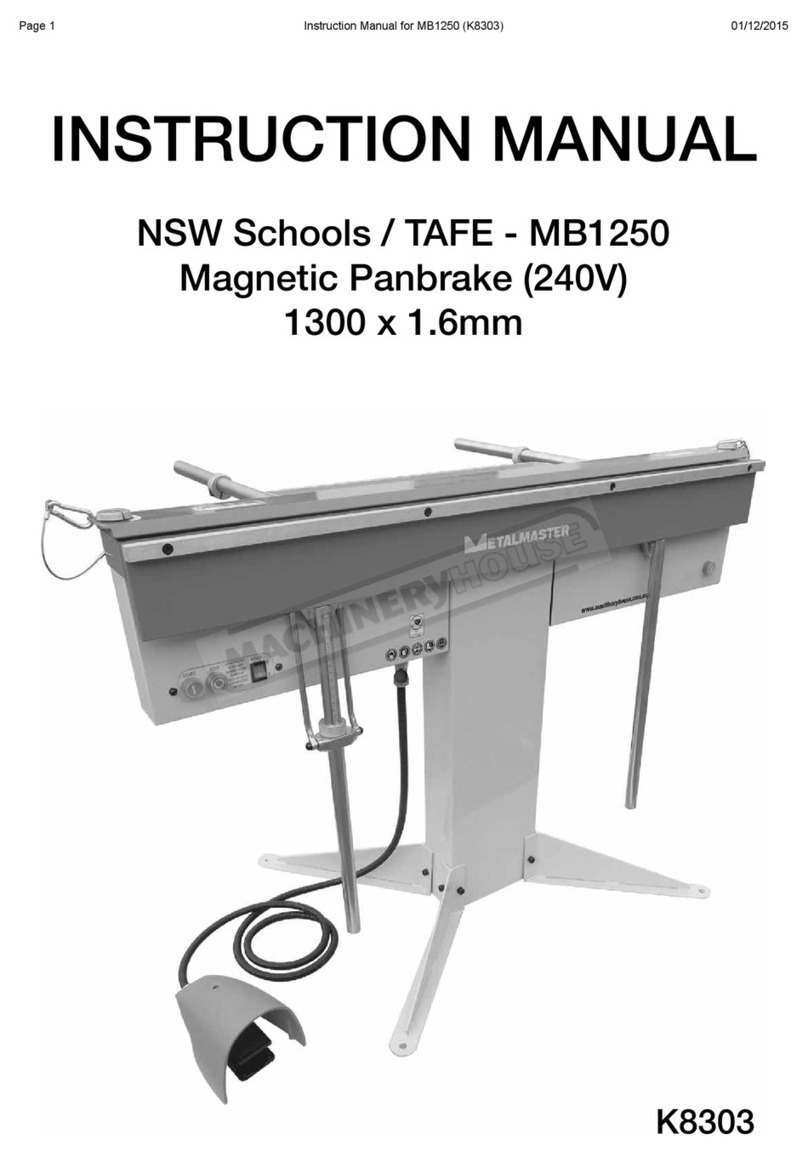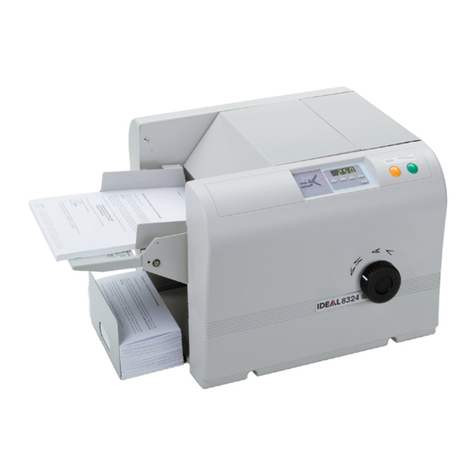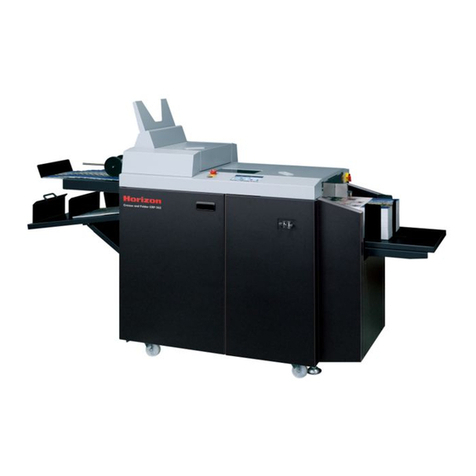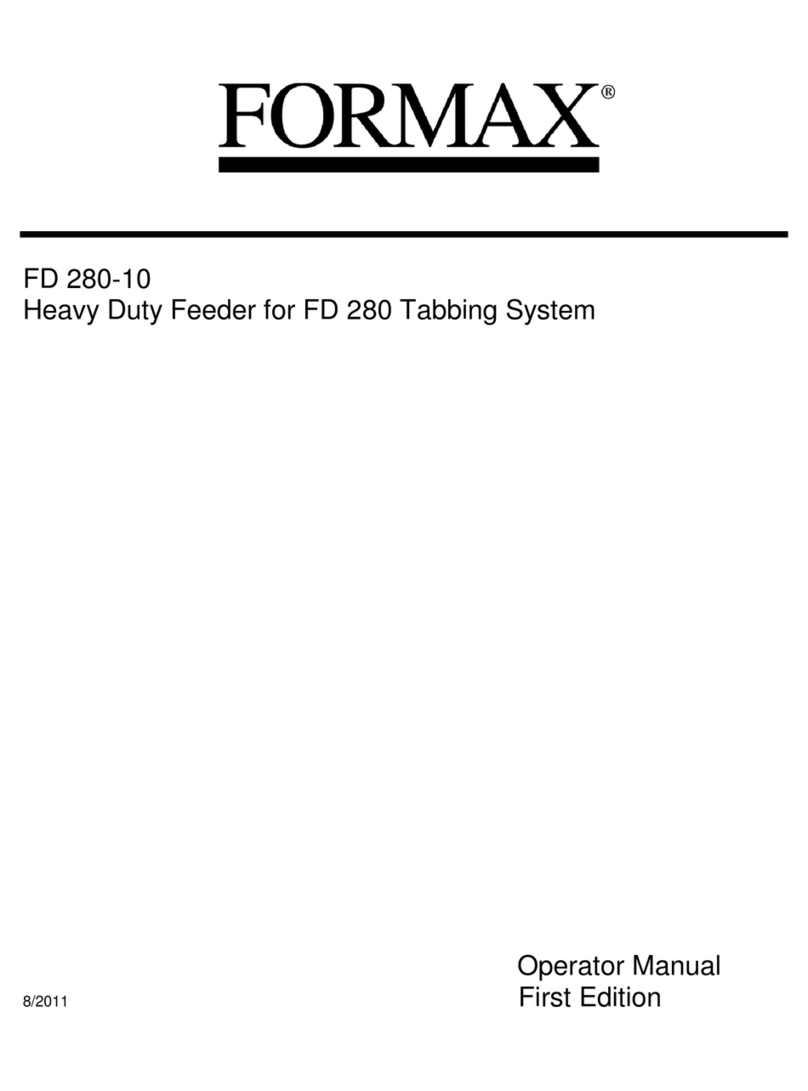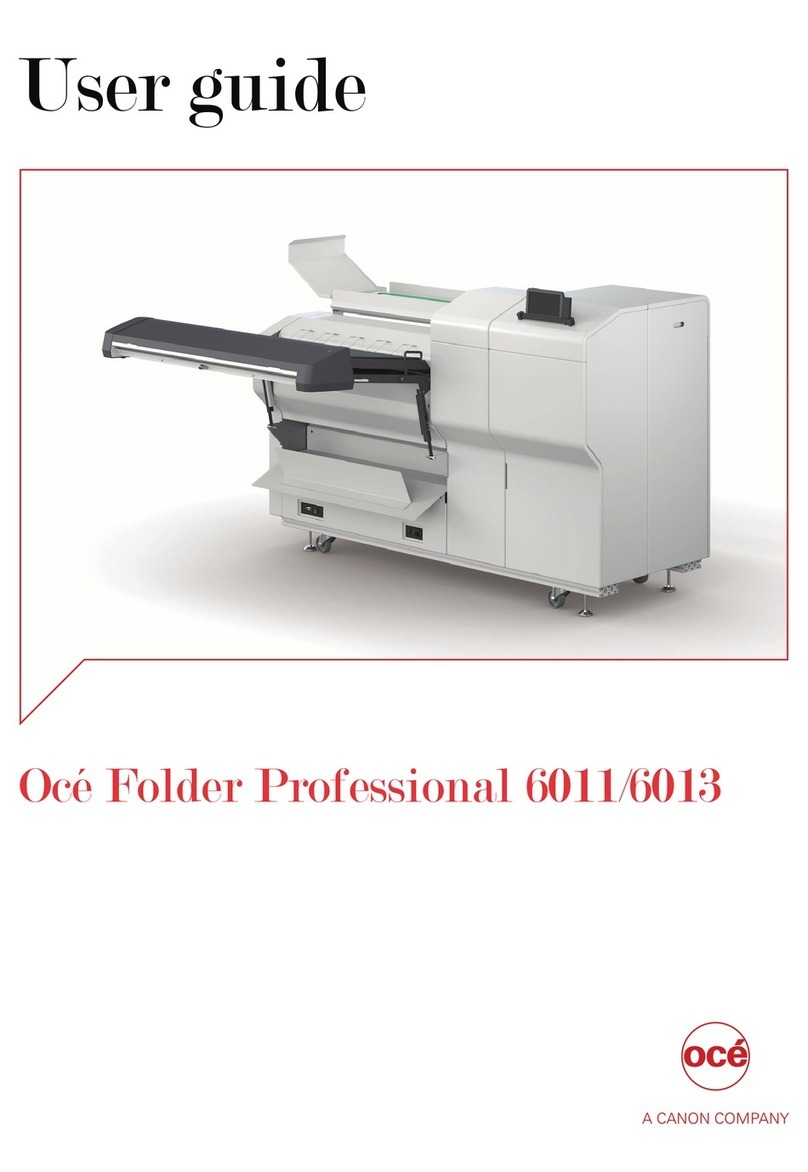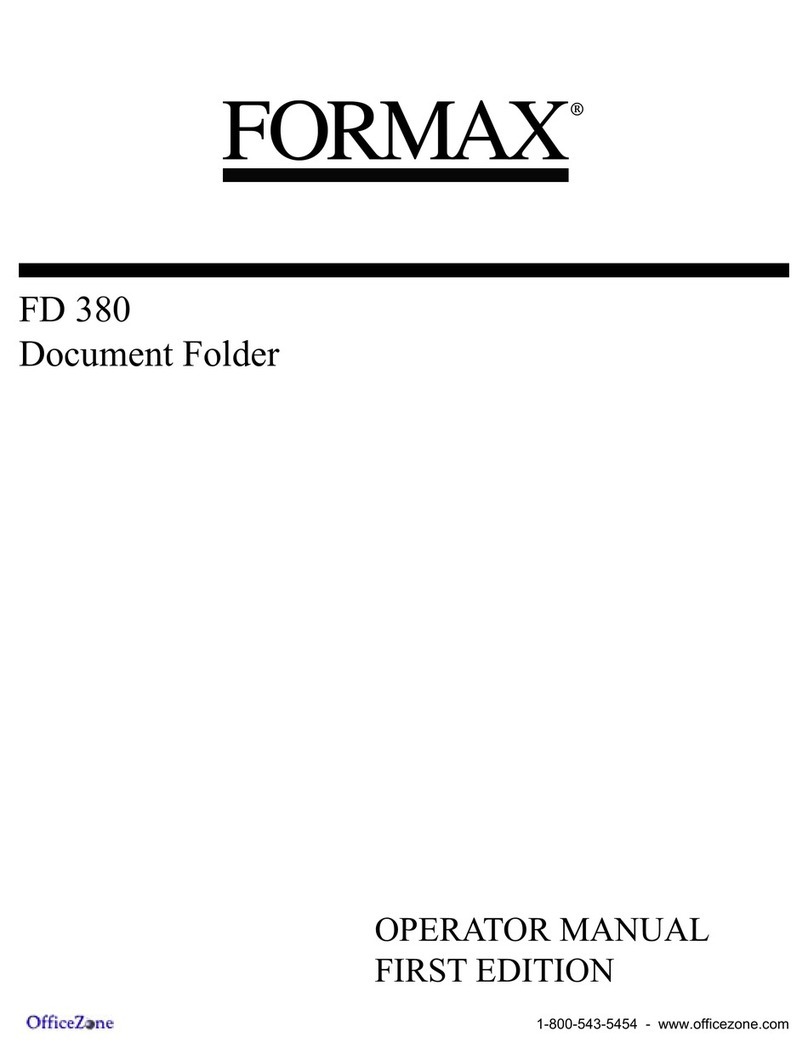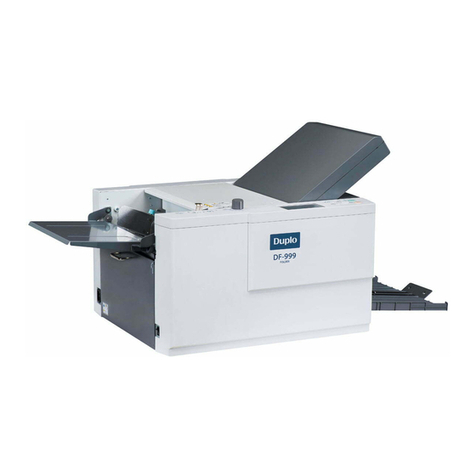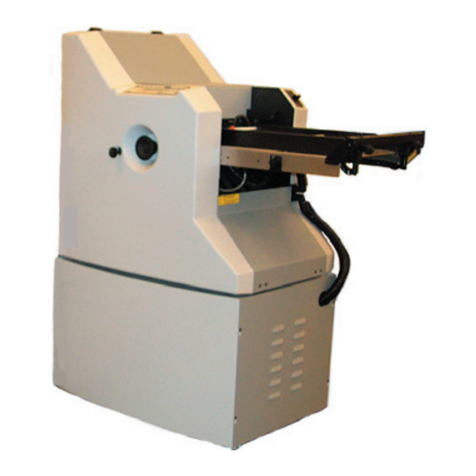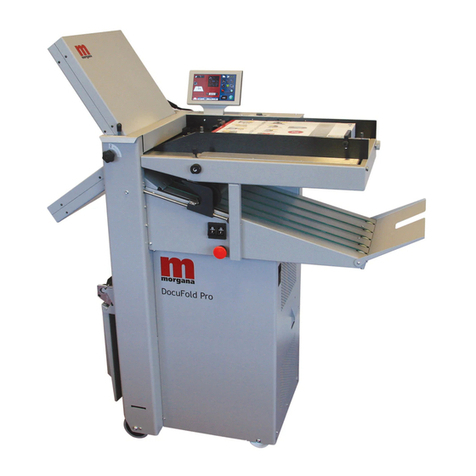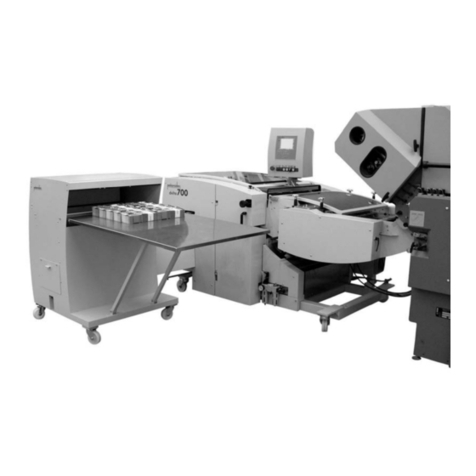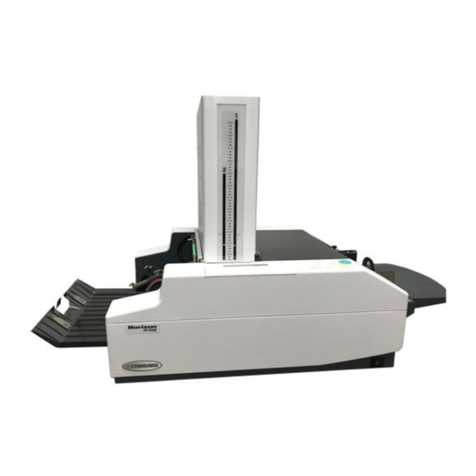Chicago Dryer Air Chicago Standard User manual

AIR CHICAGO®
(STANDARD/XW/XL/XXL)
Towel Folder
INSTRUCTION MANUAL

©Chicago Dryer Company
Instruction Manual #3019-105b
CHICAGO DRYER COMPANY
2200 N. Pulaski, Chicago, Illinois USA 60639-3737
Telephone: (773) 235-4430 Fax: (773) 235-4439 www.chidry.com

Air Chicago (Standard/XW/XL/XXL) Table of Contents
i
TABLE OF CONTENTS
MANUAL
Updates
Chapter 1 - Introduction
Chapter 2 - Installation
Chapter 3 - Operating Guidelines
Chapter 4 - Preventive Maintenance
Chapter 5 - Operating Principles
Chapter 6 - Troubleshooting
Chapter 7 - Repair
CHI PANEL BULLETIN
PICTURE PARTS LIST
SCHEMATIC PARTS LIST
APPENDIX
Floor Plans
Technical Specifications
Torque Specifications
INDEX

Table of Contents Air Chicago (Standard/XW/XL/XXL)
ii
CHAPTER 1 INTRODUCTION
1.1 Warranty .................................................................................................. 1-2
1.2 Scope of Manual ..................................................................................... 1-2
1.3 Safety ...................................................................................................... 1-3
Safe Work Habits .................................................................................... 1-3
Safety Features ....................................................................................... 1-4
1.4 Equipment Description ............................................................................ 1-6
Models and Model Designations ............................................................. 1-6
Optional Equipment ................................................................................. 1-6

Air Chicago (Standard/XW/XL/XXL) Table of Contents
iii
CHAPTER 2 INSTALLATION
2.1 Site and Utility Requirements .................................................................. 2-2
2.2 Installation Procedures ............................................................................ 2-4
Inspection ................................................................................................ 2-4
Uncrating and Positioning ....................................................................... 2-5
Compressed Air Supply Connection ....................................................... 2-6
Electrical Connection .............................................................................. 2-7
Final Protective Wrapper Removal .......................................................... 2-9
2.3 Pre-Operational Checkout ..................................................................... 2-10
Security of Hardware ............................................................................. 2-10
Compressed Air Supply Checkout .........................................................2-11
Ribbon Rotation Checkout .................................................................... 2-12
Safety Device and CHI Panel Function Checkout ................................. 2-13
Primary Fold Operation Checkout ......................................................... 2-15
Crossfold Operation Checkout .............................................................. 2-16
Checkout Completion ............................................................................ 2-16
Cleaning the Unit ................................................................................... 2-16

Table of Contents Air Chicago (Standard/XW/XL/XXL)
iv
CHAPTER 3 OPERATING GUIDELINES
3.1 Safety Features ....................................................................................... 3-2
Main Disconnect Switch .......................................................................... 3-2
Safety STOP Buttons .............................................................................. 3-2
Air Permeable Barriers (Safety Guards) ................................................. 3-2
Safety Interlock Switches ........................................................................ 3-3
Safety Labels .......................................................................................... 3-3
3.2 Operating Controls .................................................................................. 3-4
CHI Panel ................................................................................................ 3-6
3.3 Daily Operating Procedures .................................................................... 3-7
Start-Up ................................................................................................... 3-7
Handling Jams and Misfeeds Safely ....................................................... 3-8
Fold Operation ........................................................................................ 3-8
Shut-Down ............................................................................................ 3-12
3.4 Operating Techniques ........................................................................... 3-12
Processing Standards ........................................................................... 3-13
Work Habits ........................................................................................... 3-14

Air Chicago (Standard/XW/XL/XXL) Table of Contents
v
CHAPTER 4 PREVENTIVE MAINTENANCE
PM Task Table .................................................................................................... 4-1
4.1 Daily PM (8 Hours) .................................................................................. 4-2
Watch and Listen for Anything Abnormal ................................................ 4-2
General Cleanliness ................................................................................ 4-2
Check and Clean Photosensors .............................................................. 4-3
Check Safety Equipment ......................................................................... 4-3
4.2 Weekly PM (50 Hours) ............................................................................ 4-4
Check and Clean Inverter ....................................................................... 4-4
Polish Metal Surfaces ............................................................................. 4-5
Inspect Air Filter/Drain ............................................................................. 4-5
Check Air Pressure Settings ................................................................... 4-6
Check and Grease Stacker Door Bearings ............................................. 4-7
Lubricate Stacker Door Linkages ............................................................ 4-8
Check Belt and Ribbon Condition and Tension ....................................... 4-8
4.3 Monthly PM (200 Hours) ......................................................................... 4-9
Check Setscrews..................................................................................... 4-9
Clean and Lubricate Drive Chains ........................................................ 4-10
4.4 Semi-Annual PM (1000 Hours) ..............................................................4-11
Clean and Lubricate Threaded Rods .....................................................4-11
Clean Air Filter/Auto Drain ..................................................................... 4-13
Inspect Gear Reduction Unit ................................................................. 4-14
4.5 Annual PM (2000 Hours) ....................................................................... 4-15
Check All Electrical Connections ........................................................... 4-15
Check Insulation Resistance to Earth Ground ...................................... 4-16

Table of Contents Air Chicago (Standard/XW/XL/XXL)
vi
CHAPTER 5 OPERATING PRINCIPLES
Safety ................................................................................................................ 5-2
5.1 Electrical System ..................................................................................... 5-2
Power System ......................................................................................... 5-2
Control System ........................................................................................ 5-6
5.2 Compressed Air System ........................................................................ 5-10
Air Filter/Regulators............................................................................... 5-10
Air Pressure Switch ............................................................................... 5-10
Air Reservoir .......................................................................................... 5-10
Air Valves/Air Valve Solenoids ...............................................................5-11
Air Cylinder .............................................................................................5-11
Air Manifolds (Air Bars/Air Jets) .............................................................5-11
Pneumatic Clutch/Brake .........................................................................5-11
5.3 Mechanical System ............................................................................... 5-12
Main Drive System ................................................................................ 5-12
Primary Fold Ski Drive System .............................................................. 5-12
Stacker Drive System ............................................................................ 5-13
Exit and Return Drive Systems ............................................................. 5-13
Ribbon Sets ........................................................................................... 5-14
5.4 Sequence of Operation ......................................................................... 5-15
Stand-by Phase ..................................................................................... 5-15
Start-up Phase ...................................................................................... 5-15
Primary Fold Phase ............................................................................... 5-16
Crossfold Phrase ................................................................................... 5-16
Stacking Phase ..................................................................................... 5-16

Air Chicago (Standard/XW/XL/XXL) Table of Contents
vii
CHAPTER 6 TROUBLESHOOTING
Troubleshooting Symptoms ............................................................................... 6-2
6.1 CHI Diagnostic Message Index ............................................................... 6-6
6.2 LED Diagnostics ...................................................................................... 6-8
6.3 Electrical ................................................................................................ 6-10
6.4 Mechanical ............................................................................................ 6-13
6.5 Primary Folding ..................................................................................... 6-14
6.6 First Crossfold ....................................................................................... 6-17
6.7 Second Crossfold .................................................................................. 6-19
6.8 Stacker .................................................................................................. 6-20
6.9 Exit/Return Conveyors .......................................................................... 6-21
6.10 Sensor Function .................................................................................... 6-22
6.11 CHI Panel .............................................................................................. 6-23
6.12 Compressed Air System ........................................................................ 6-24

Table of Contents Air Chicago (Standard/XW/XL/XXL)
viii
CHAPTER 7 REPAIR
7.1 Safety Considerations ............................................................................. 7-2
7.2 Parts Availability ...................................................................................... 7-3
7.3 Ribbons ................................................................................................... 7-3
Inlet Ribbon Tension Adjustment ............................................................. 7-4
Primary Fold Ribbon Tension Adjustment ............................................... 7-4
Intermediate Ribbon Tension Adjustment ................................................ 7-5
Transfer Ribbon Tension Adjustment ...................................................... 7-6
Stacker Ribbon Tension Adjustment ........................................................ 7-7
Exit Conveyor Ribbon Tension Adjustment ............................................. 7-8
Return Conveyor Ribbon Tension Adjustment ......................................... 7-9
Ribbon Replacement ............................................................................. 7-10
7.4 Rolls ...................................................................................................... 7-12
First Crossfold Pinch Point Gap Adjustment ......................................... 7-12
Tracking Tape Overview ........................................................................ 7-14
White Tracking Tape Replacement ........................................................ 7-15
Grey Tracking Tape Replacement ......................................................... 7-16
Riveted Tracking Tape Replacement ..................................................... 7-17
7.5 Chains and Belts ................................................................................... 7-19
Main Drive Chain Tension Adjustment ................................................... 7-19
Primary Fold Ski Drive Chain Tension Adjustment ................................ 7-20
Primary Fold Ribbon Drive Chain Tension Adjustment .......................... 7-21
Transfer Ribbon Drive Chain Tension Adjustment ................................. 7-22
Inlet Ribbon Drive Belt Tension Adjustment .......................................... 7-23
Stacker Ribbon Drive Belt Tension Adjustment ..................................... 7-24
Primary Fold Ski Position Adjustment ................................................... 7-25
7.6 Mechanical Adjustments ....................................................................... 7-28
Primary Fold Conveyor Stop Position Adjustment ................................ 7-28
Clutch Adjustment ................................................................................. 7-29
Second Crossfold Steel Fingers Adjustment ......................................... 7-30
Stacker Door Mechanical Adjustments ................................................. 7-31

Air Chicago (Standard/XW/XL/XXL) Table of Contents
ix
7.7 Sensors ................................................................................................. 7-32
Photosensor Replacement .................................................................... 7-32
Primary Fold Ski Position Detect Proximity Sensor Adjustment ............ 7-34
Primary Fold Ski Position Detect Proximity Sensor Replacement ........ 7-35
Stacker Proximity Sensor Adjustment ................................................... 7-36
Stacker Proximity Sensor Replacement ................................................ 7-38
Primary Fold Skis Limit Switch Adjustment ........................................... 7-39
7.8 Compressed Air System ........................................................................ 7-41
Primary Fold Air Manifold Alignment ..................................................... 7-41
Crossfold Air Manifold Alignment .......................................................... 7-42
Stacker Door Air Cylinder Air Flow Adjustment ..................................... 7-43
Air Valve Repair ..................................................................................... 7-44

Air Chicago (Standard/XW/XL/XXL) Operating Guidelines
3-1
Chapter 3
OPERATING GUIDELINES
To operate the Air Chicago® folder safely and efficiently, personnel must know and follow recommended
procedures:
3.1 Safety Features
3.2 Operating Controls
3.3 Daily Operating Procedures
3.4 Operating Techniques
NOTE: It is extremely important that daily operation of the unit be properly supervised
at all times. All operating and maintenance personnel must read, understand, and
follow the Operator Safety Reminders for CHICAGO® Flatwork Folder (Figure 3-1).
This bulletin must be posted at the operating site.
Figure 3-1: The Operator Safety Reminders bulletin must be
posted and must be read by all personnel.

Operating Guidelines Air Chicago (Standard/XW/XL/XXL)
3-2
3.1 Safety Features
The folder is manufactured with several built
in features to promote safety and proper operating
procedures.
There are five categories of safety features:
Main Disconnect Switch
Safety STOP Buttons
Air Permeable Barriers (Safety Guards)
Safety Interlock Switches
Safety Labels
•
•
•
•
•
Main Disconnect Switch
The main disconnect switch (Figure 3-2) is
located on the electrical connection box at the
left front of the unit. When turned to OFF, the
main disconnect switch locks out the incoming
electrical power to the unit.
Unless otherwise indicated, turn the main
disconnect switch to OFF before performing any
maintenance or repair work.
For more information on operating the main
disconnect switch, refer to the INSTALLATION
chapter, Installation Procedures section,
Electrical Connection procedure.
Safety STOP Buttons
Pressing any of the three red safety STOP
buttons (Figure 3-3, A) immediately stops all
rotating parts. Twist to release/reset a pressed
STOP button.
The preferred method of stopping the operation
of the unit is by pressing the red STOP button in
the center control panel.
Air Permeable Barriers (Safety
Guards)
A split air permeable barrier, which covers
the top of the unit (Figure 3-3, B), has a safety
function as well as helping to make the primary
folds. It helps prevent fingers or hands from
coming into contact with moving parts.
It also serves to keep objects, other than items
to be folded, from entering the unit and damaging
components. Lifting either section of the barrier
immediately stops all rotating parts.
Figure 3-2: The main disconnect switch is located
on the electrical connection box at the
right front of the unit.
Figure 3-3: Three STOP buttons (A) and the air
permeable barriers (safety guards) (B)
help provide for operator safety.
A
B

Air Chicago (Standard/XW/XL/XXL) Operating Guidelines
3-3
Safety Interlock Switches
The folder is equipped with interlock switches
on each of the endframe panels (Figure 3-4)
and at the rear protective panel. Removing or
opening a panel during operation will shut down
the folder.
These switches are not intended to lockout
the unit. Site management is responsible for
developing and implementing procedures that
follow government standards for lockout/tagout
when servicing the folder.
Safety Labels
WARNING (orange) and CAUTION (yellow)
labels are placed at locations around the unit to
keep operators and maintenance personnel alert
in particular areas (Figure 3-5).
WARNING labels alert personnel that
personal injury may result from not following
recommended procedures.
CAUTION labels alert personnel that the
unit may be damaged if conditions, practices, or
procedures are not observed.
When training operators, take the time to
review, understand, and locate all areas where
labels are posted.
NOTE: Do not remove safety
labels at any time. If a label
needs to be replaced, contact
Chicago Dryer Company for free
replacements.
Figure 3-5: Safety labels remind operators and
maintenance personnel that care must
be taken when working near these
areas.
Figure 3-4: Interlock switches shut off the unit
when a panel is opened or removed.

Operating Guidelines Air Chicago (Standard/XW/XL/XXL)
3-4
3.2 Operating Controls
All operating controls are externally mounted
on the endframes and clearly marked with
functional names. References to these functions are
capitalized in this manual for easy identification.
Detailed descriptions are given in the following
paragraphs.
Controls at the front unit include (Figure 3-
6):
JAM ALARM (A)
START button (B)
STOP button (C)
INLET PAUSE ON/OFF switch (D)
STAIN/TEAR REJECT button (E)
ADVANCE CONVEYOR button (F)
JOG REVERSE button (G)
Safety STOP button (H)
Pacing Light (Option) (I)
•
•
•
•
•
•
•
•
•
JAM ALARM (A)
Sounds to indicate jams in the unit. It also
alerts operators to check the CHI Panel display
for diagnostic messages.
START button (B)
Initiates normal start-up and operation of the
unit. A green indicator lamp, located under the
switch surface, lights when the START button is
pushed. This indicates that power is connected
to the motors. The rotating parts associated with
primary fold operation begin to move. The control
logic will be active for the CHI panel settings.
STOP button (C)
Stops operation of the rotating and conveying
elements.
Figure 3-6: All operating controls for the unit are conveniently located on the front panel.
CDE
AB
I
FG
H

Air Chicago (Standard/XW/XL/XXL) Operating Guidelines
3-5
INLET PAUSE ON/OFF switch (D)
When in the ON position, briefly pauses an
item on the inlet conveyor if it is fed too closely
to the previous item.
If the unit is equipped with the Inlet Ribbon
Delay option, this control is a push button which
allows the operator to activate the inlet conveyor
before the programmed delay time has elapsed.
For more information within this manual, refer
to the CHI PANEL Bulletin, Programming
Section, Feed Programming information.
STAIN/TEAR REJECT button (E)
Keeps a defective piece from being folded.
Pressing the button overrides the various fold
settings and causes the piece to be discharged at
the rear of the unit. The button should be pushed
as soon as the defective piece is fed into the
machine.
ADVANCE CONVEYOR button (F)
Moves the ribbons on the return and side
conveyors, regardless of the current stack size.
It also resets the Stack Count.
JOG REVERSE button (G)
Moves the ribbons of the Air Chicago backward.
This should only be used briefly to clear a jam.
WARNING
Never put hands into the
machine while the power is
on. This is dangerous and
unnecessary.
Safety STOP button (H)
Provided to help ensure operator safety and to
prevent damage to the unit. There are three red
safety STOP buttons, one at the left front of the
unit and two at the rear.
When pressed, these stop all machine moving
parts and lock out operation of the machine. A
red safety STOP button stays pressed down until
manually reset by twisting.
Before restarting the unit, correct the problem
that resulted in the red safety STOP button being
pressed.
NOTE: JOG REVERSE will not
operate when a red safety STOP
button is pushed.
Pacing Light (Option) (I)
Gives operators a visual reference to help
assure consistent flatwork processing.
Green—feeding rate for the previous
minute has been met.
Red—flashes when operator’s feed rate
is slower than programmed; steady in
MANUAL mode to indicate a program
is not being used.
The feed rate is adjustable. For more information,
refer to the CHI PANEL OPERATION bulletin,
Programming section.
•
•

Operating Guidelines Air Chicago (Standard/XW/XL/XXL)
3-6
CHI Panel
The CHI panel (Figure 3-7) allows fully
automatic operation of the Air Chicago for a wide
range of folding needs. The Air Chicago can be
set to hold up to sixteen (16) programs.
NOTE: The standard display is
the folder’s speed and the item
count.
The ADJUST button (A) is used for adjusting
various folding parameters and is only used when
the unit is operating in manual mode.
The CD programming button (B) is used to
change the preset program settings for the SIZE
SELECT buttons.
The TEST button (C) is used during
troubleshooting. The fold system must be
off (manual mode) in order to access the test
functions.
The CHI panel Display (D) varies depending
upon which mode is currently selected. It shows
the various fold system settings, diagnostic
messages, etc.
The CURSOR button (E) moves the cursor
to various positions in the CHI panel Display in
order to change settings.
The “-” and “+” buttons (F and G) are used
to increase and decrease the various fold system
settings. The “-” button is also used to reset the
item counter.
The ENTER button (H) confirms a selection
from a menu, or to store new information.
The SIZE SELECT buttons (I) place the unit
in automatic mode and are used to select one of
the up to 16 possible programs.
The WIDTH buttons (J) are used to manually
set the space between the primary fold skis. These
buttons are only used when the unit is operating
in manual mode.
The AIR LO/HI button (K) selects one of
two levels of air pressure to facilitate the primary
folding of different weights of items. Processing
lighter weight items requires less air pressure than
heavier items. This button is only used when the
unit is operating in manual mode.
The CROSS button (L) is used to select a
choice of crossfold patterns including half folds,
French (1/3) folds, or quarter folds. This button
is only used when the unit is operating in manual
mode.
Figure 3-7: The Chicago High Intelligence
(CHI) control panel.
A B C
D
E F G H
I
J K L

Air Chicago (Standard/XW/XL/XXL) Operating Guidelines
3-7
3.3 Daily Operating
Procedures
In the daily operation of the unit, it is desirable
to follow consistent operational procedures.
By training operators to follow the same set of
guidelines for daily procedures, operator safety
and efficiency are maximized.
Daily routines include:
Start-Up
Handling Jams and Misfeeds Safely
Fold Operation
Shut Down
Start-Up
The following steps are suggested for starting
the Air Chicago at the beginning of each day:
Perform all daily preventive maintenance
and cleaning procedures. For more in-
formation, refer to the PREVENTIVE
MAINTENANCE chapter, Daily PM
section.
Have flatwork sorted and ready to pro-
cess.
Turn power ON at the main electrical
disconnect switch to the unit.
Turn ON the compressed air supply to
the unit.
Press the green START button. The indica-
tor lamp in the switch lights and the CHI
Panel begins its start-up diagnostics. Then,
the primary fold ribbons begin moving.
•
•
•
•
1.
2.
3.
4.
5.
Perform a safety check:
Press a red safety STOP button. All
moving parts should stop and an error
message should display in the CHI
Panel.
Reset the red safety STOP button by
twisting it clockwise.
Restart the unit.
Test the other two red safety STOP
buttons in the same manner.
Restart the unit.
Raise one section of the air perme-
able barrier (wire guard). All moving
parts should stop and an error message
should display in the CHI Panel.
Restart the unit and test the other sec-
tion of the air permeable barrier (wire
guard).
Restart the unit and let it run. The CHI
Panel completes its diagnostics and initial
display.
The CHI Panel then displays:
A1 HAND TOWEL
00000
The machine is now ready for operation.
Press the desired SIZE SELECT button.
Throughout the day, monitor the condition
of the flatwork and check the condition of
each piece.
CAUTION
Do not process towels or
other items with frayed
edges and/or loose threads.
6.
•
•
•
•
•
•
•
7.
8.
9.
10.
11.

Operating Guidelines Air Chicago (Standard/XW/XL/XXL)
3-8
Handling Jams and Misfeeds Safely
During normal operation, items will
occasionally feed incorrectly into the unit or
become jammed during the folding process. The
alarm sounds and a flashing message on the CHI
Panel display tells where the jam is.
Stop feeding items into the unit.
Look at the CHI display to see where the
jam is.
CAUTION
The folder was not made to
run in reverse. Use the JOG
REVERSE button only for
very short jogs.
Press and release the JOG REVERSE but-
ton in short jogs to see if the item can be
backed out easily.
Turn power OFF at the main disconnect
switch.
WARNING
Never reach into the machine
while it is running.
Serious injury could result.
Remove the jammed material by hand.
NOTE: F r e q u e n t j a m m i n g
may indicate that the unit needs
adjustment or repair. Operators
should inform appropriate
personnel if there is a consistent
problem.
1.
2.
3.
4.
5.
Fold Operation
The Air Chicago fold system is centrally
operated through the CHI (Chicago High
Intelligence) control panel. The CHI Panel makes
it easy to operate, program, adjust and test the
folding system. The CHI fold system control
panel (Figure 3-7) is located at front right of the
unit.
Fold operations include:
Folding Accuracy
Automatic Operation
Manual Operation
Counters
Self-Diagnostics
Programing, Adjustment, Testing
•
•
•
•
•
•

Air Chicago (Standard/XW/XL/XXL) Operating Guidelines
3-9
Folding Accuracy
To get accurate folds, towels must be fed
accurately into the Air Chicago. Each item must
be placed straight on the inlet ribbons.
Place the item on the inlet ribbons according
to whether a French or a half primary fold is
desired.
Figure 3-8: To get a correct French-style primary
fold, the towel must be properly
centered on the inlet ribbons.
Towel Primary Fold Skis
1/3 1/31/3
1st Air Blast
2nd Air Blast
TOWEL
Primary Fold Skis
Figure 3-9: Position the towel so that it is centered
on the edge of the left primary fold ski
for a half primary fold.
Towel Primary Fold Skis
1/2 1/2
1st Air Blast
TOWEL
Primary Fold Skis
For a proper French primary fold, the towel
must be centered on the inlet ribbons so that the
primary fold skis divide it evenly into thirds as
illustrated in Figure 3-8.
Half primary folds are obtained by feeding the
item on the left side of the Air Chicago. Position
the towel so that it is centered on the outside
edge of the left primary fold ski, as illustrated
in Figure 3-9.
Other manuals for Air Chicago Standard
1
This manual suits for next models
3
Table of contents
Other Chicago Dryer Folding Machine manuals


